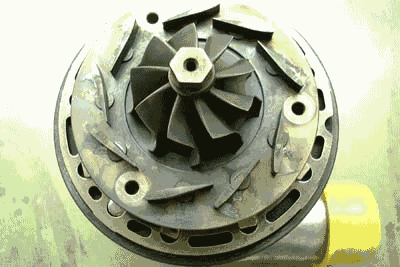Уважаеми колеги,не намерих такава тема във форума и затова си позволявам да направя сравнение между двигателите с принудително пълнене.Не се изживявам като капацитет по темата,но ще се опитам да пиша на разбираем език.
Турбо:Две турбини,с обща ос,с различна големина.Малката турбинка се върти от газовете на изходящия колектор(стеснен на определено място с цел увеличаване на скороста на изходящите газове),при въртенето си задвижва по-голямата турбина.Голямата турбина нагнетява въздуха постъпващ в смукателния колектор.Малката турбина с помоща на изходящите газове се развърта до около 90к оборота в минута .За сега няма лагери,които да издържат подобни скорости,затова се налага общата ос да плува в масло(идва от ДВГ).Което от своя страна изисква маслото да се охлажда.Другия проблем е че при тези скорости турбините се загряват прекомерно,голямата турбина нагрява постъпващия въздух.Това от своя страна води до обедняване на горивната смес(по-топъл въздух=по-малко кислород в горивната смес=по-лошо изгаряне)Затова се налага монтирането на интеркулер(топлообменник за постъпващия в ДВГ въздух)Кулера се мотира след турбото,т.е. в него постъпва вече компримирания въздух.Тук обаче възниква друг проблем.При голям кулер турбото несмогва да ,,надуе''въздуха в него,от там се увеличава така наречения турбо лаг(диапазона от обороти,в които чувстваме ,,турбо ритника'')Още един проблем е стесняването на изпускателния тракт,с цел повишаване на кинетичната енергия на изходящите газове-трябва да се намери компромис между това турбото да се развърта бързо и затормозената работа на ,,запушения отзад ''ДВГ.Сега обаче идва следния въпрос:Турбото надува ,двигателя пее,но се налага смяна на по-ниска предавка.Оборотите се вдигат,респективно скороста на изходящите газове скача,а ДВГ е вече напомпан?Вместо колата да забави ход(моторна спирачка)турбото помпа в неподходящия момент и дава мощност...Би трябвало да избухне?Тук идва на помощ ,,wastegate''клапана,не позволяващ повишаване на налягането след определена стойност(просто ги пуска покрай турбото).Другия вариант,пълна газ,двигателя влиза в лютеницата,смяна на по-висока предавка.Оборотите падат,малката турбина забавя голямата ,която от своя страна тормози всмукателната система.За намаляването на този (д)ефект се монтират т.нар ,,blow off''клапани,които помагат да се запази част от налягането,необходимо да се запази турбината,,жива'' Турбо двигателите са най-разпространения вид ДВГ с принудително пълнене.
.За сега няма лагери,които да издържат подобни скорости,затова се налага общата ос да плува в масло(идва от ДВГ).Което от своя страна изисква маслото да се охлажда.Другия проблем е че при тези скорости турбините се загряват прекомерно,голямата турбина нагрява постъпващия въздух.Това от своя страна води до обедняване на горивната смес(по-топъл въздух=по-малко кислород в горивната смес=по-лошо изгаряне)Затова се налага монтирането на интеркулер(топлообменник за постъпващия в ДВГ въздух)Кулера се мотира след турбото,т.е. в него постъпва вече компримирания въздух.Тук обаче възниква друг проблем.При голям кулер турбото несмогва да ,,надуе''въздуха в него,от там се увеличава така наречения турбо лаг(диапазона от обороти,в които чувстваме ,,турбо ритника'')Още един проблем е стесняването на изпускателния тракт,с цел повишаване на кинетичната енергия на изходящите газове-трябва да се намери компромис между това турбото да се развърта бързо и затормозената работа на ,,запушения отзад ''ДВГ.Сега обаче идва следния въпрос:Турбото надува ,двигателя пее,но се налага смяна на по-ниска предавка.Оборотите се вдигат,респективно скороста на изходящите газове скача,а ДВГ е вече напомпан?Вместо колата да забави ход(моторна спирачка)турбото помпа в неподходящия момент и дава мощност...Би трябвало да избухне?Тук идва на помощ ,,wastegate''клапана,не позволяващ повишаване на налягането след определена стойност(просто ги пуска покрай турбото).Другия вариант,пълна газ,двигателя влиза в лютеницата,смяна на по-висока предавка.Оборотите падат,малката турбина забавя голямата ,която от своя страна тормози всмукателната система.За намаляването на този (д)ефект се монтират т.нар ,,blow off''клапани,които помагат да се запази част от налягането,необходимо да се запази турбината,,жива'' Турбо двигателите са най-разпространения вид ДВГ с принудително пълнене.
Компресорни ДВГ(два подвида)
ДВГ пълнени от винтов компресор(Super charger)
Монтират се на бавнооборотни ДВГ с голяма кубатура.Системата за принудително пълнене тук е винтов компресор( два винта с едра резба нагнетяват въздуха в смукателните колектори)Развъртат се при ниски обороти.Характеристиките и се дават във вид на обикновена дроб-обороти на коляновия вал/обороти на компресора.Т.е налягането се определя от оборотите на коляновия вал и големината на винтовете на компресора.Затова може да се видят американски коли,на които ДВГ се подава 30 см над капака.Другите помощни системи са като описаните по-горе.
ДВГ се пълни от роторен компресор.Роторния компресор е подобен на голямата турбина при турбомоторите.Само че тук липсва малката турбинка.Развъртането на компресора се осигурява чрез ремъчна предавка,куплирана с ДВГ.Тук за да се осигури налягане,е необходим бързооборотен ДВГ и турбото ефекта се усеща във високите обороти.За осигуряване на висока скорост на компресора(по-високо налягане) се избират предавателни шайби с различен диаметър(голяма от ДВГ и възможно по-малка на компресора)
Надявам се да ви хареса
Турбо:Две турбини,с обща ос,с различна големина.Малката турбинка се върти от газовете на изходящия колектор(стеснен на определено място с цел увеличаване на скороста на изходящите газове),при въртенето си задвижва по-голямата турбина.Голямата турбина нагнетява въздуха постъпващ в смукателния колектор.Малката турбина с помоща на изходящите газове се развърта до около 90к оборота в минута
Компресорни ДВГ(два подвида)
ДВГ пълнени от винтов компресор(Super charger)
Монтират се на бавнооборотни ДВГ с голяма кубатура.Системата за принудително пълнене тук е винтов компресор( два винта с едра резба нагнетяват въздуха в смукателните колектори)Развъртат се при ниски обороти.Характеристиките и се дават във вид на обикновена дроб-обороти на коляновия вал/обороти на компресора.Т.е налягането се определя от оборотите на коляновия вал и големината на винтовете на компресора.Затова може да се видят американски коли,на които ДВГ се подава 30 см над капака.Другите помощни системи са като описаните по-горе.
ДВГ се пълни от роторен компресор.Роторния компресор е подобен на голямата турбина при турбомоторите.Само че тук липсва малката турбинка.Развъртането на компресора се осигурява чрез ремъчна предавка,куплирана с ДВГ.Тук за да се осигури налягане,е необходим бързооборотен ДВГ и турбото ефекта се усеща във високите обороти.За осигуряване на висока скорост на компресора(по-високо налягане) се избират предавателни шайби с различен диаметър(голяма от ДВГ и възможно по-малка на компресора)
Надявам се да ви хареса



Коментар